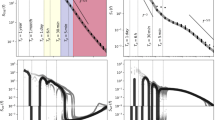Abstract
Beljaars et al. (1987) developed a model for neutrally stratified boundary-layer flow over roughness changes and topography. It has been discovered that a constant parameter, α, was missing in the algebraic-stress closure equations of their paper. This omission also occurred in the MSFD model code but only affects the Askervein Hill shear-stress results for the E-ε-Τ turbulence closure in Beljaars et al. It also changes the stress results of Karpik (1988), but not his conclusions regarding the robustness of his improved numerical scheme. The present paper demonstrates the effect of the omission of the parameter, α, and tests the sensitivity of the model to variations in its value. The new results are compared with the data and model results of Zeman and Jensen (1987).
Similar content being viewed by others
References
Beljaars, A. C. M., Walmsley, J. L., and Taylor, P. A.: 1987, ‘A Mixed Spectral Finite-Difference Model for Neutrally Stratified Boundary-Layer Flow Over Roughness Changes and Topography’, Boundary-Layer Meteorol. 38, 273–303.
Hanjalic, K. and Launder, B. E.: 1972, ‘A Reynolds Stress Model of Turbulence and its Application to Thin Shear Flows’, J. Fluid Mech. 52, 609–638.
Finnigan, J. J.: 1988, ‘Air Flow over Complex Terrain’, in W. L. Steffen and O. T. Denmead (eds.), Flow and Transport in the Natural Environment: Advances and Applications, Springer-Verlag, Berlin, pp. 183–229.
Karpik, S. R.: 1988, ‘An Improved Method for Integrating the Mixed Spectral Finite Difference (MSFD) Model Equations’, Boundary-Layer Meteorol. 43, 273–286.
Launder, B. E.: 1975, Prediction Methods for Turbulent Flows. Von Kármán Institute, Rhode-St-Genese, Belgium.
Mickle, R. E., Cook, N. J., Hoff, A. M., Jensen, N. O., Salmon, J. R., Taylor, P. A. Tetzlaff, G., and Teunissen, H. W.: 1988, ‘The Askervein Hill Project: Vertical Profiles of Wind and Turbulence’, Boundary-Layer Meteorol. 43, 143–169.
Panofsky, H. A. and Dutton, J. A.: 1984, Atmospheric Turbulence: Models and Methods for Engineering Applications. John Wiley & Sons, New York, 397 pp.
Taylor, P. A.: 1977, ‘Some Numerical Studies of Surface Boundary-Layer Flow above Gentle Topography’, Boundary-Layer Meteorol., 11, 439–465.
Zeman, O. and Jensen, N. O.: 1987, ‘Modification of Turbulence Characteristics in Flow over Hills’, Quart. J. Roy. Meteorol. Soc. 113, 55–80.
Author information
Authors and Affiliations
Rights and permissions
About this article
Cite this article
Walmsley, J.L., Padro, J. Shear stress results from a mixed spectral finite-difference model: Application to the Askervein Hill project data. Boundary-Layer Meteorol 51, 169–177 (1990). https://doi.org/10.1007/BF00120466
Accepted:
Issue Date:
DOI: https://doi.org/10.1007/BF00120466




